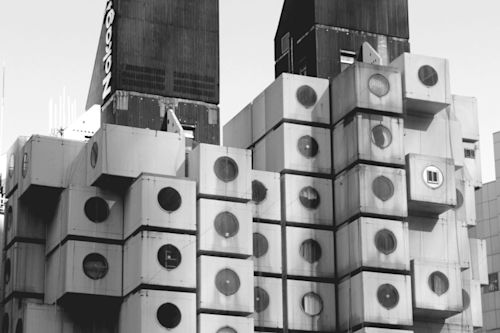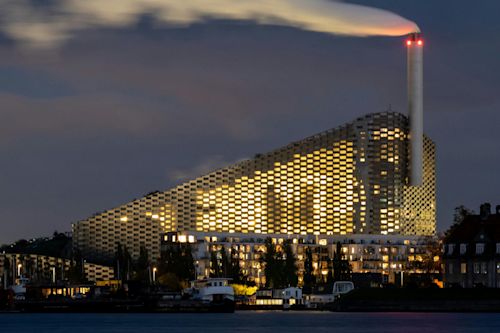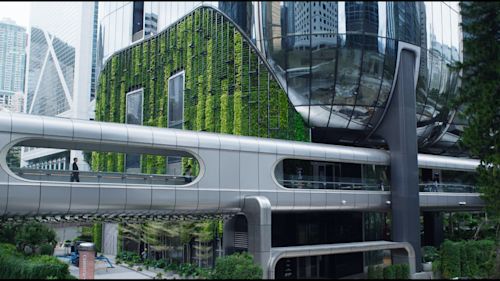"No house should ever be on a hill or on anything. It should be of the hill. Belonging to it. Hill and house should live together each the happier for the other." This phrase by American architect Frank Lloyd Wright (1867–1959), found in his bookFrank Lloyd Wright: An Autobiography, serves as the starting point for understanding organic architecture.
This architectural style emerged in the early twentieth century, during the same period as Art Nouveau, and in contrast to the rationalist forms of the Modern Movement.
Organic architecture seeks to design buildings in harmony with their natural surroundings, promoting a balance between human beings and nature. The concept is rooted in the belief that architecture should not be something foreign to the environment, but rather an extension of it.
Frank Lloyd Wright is considered the father of organic architecture. He first used the term in 1908 to describe buildings in which form, function, and materials interact with the surrounding landscape. The concept resurfaced in an article for “Architectural Record”and was later expanded upon in “Organic Architecture”, a book that compiles four lectures Wright delivered at the Royal Institute of British Architects (RIBA) in London in 1939.
5 Distinctive Elements to Recognize Organic Architecture

Organic architecture stands in contrast to the rigidity of traditional architectural schemes, offering instead a fluid, integrated design that connects seamlessly with its environment. Its primary aim is to create spaces that respect human needs while drawing on natural materials and forms inspired by the organic world. Notable architects associated with this style, in addition to Frank Lloyd Wright, include Bruce Goff, Richard Neutra, Rudolf Schindler, Alvar Aalto, and Paolo Soleri. The defining features of this architectural style are:
Integration with natureBuildings are designed to blend with the surrounding landscape, using local materials and adapting to the site’s natural geography. The structure should not merely exist in nature—it should emerge from it. This harmony extends to color choices as well, both interior and exterior, which should complement and converse with the natural setting.
Use of natural materialsWood, stone, glass, and other organic materials are preferred to foster both visual and functional harmony with the environment.
Fluid and biomorphic shapes, combined with uniquenessStructures take inspiration from natural forms, avoiding rigid lines and sharp angles. Each building is conceived as a one-of-a-kind creation, tailored to its occupants—whose uniqueness should be reflected and celebrated in the design.
Open and bright spacesExpansive windows and open interiors allow natural light to flow in, strengthening the connection between indoor and outdoor spaces.
Sustainability and respect for the environmentOrganic architecture seeks to minimize ecological impact by incorporating renewable energy sources and environmentally conscious construction methods.
5 Examples of Iconic Organic Architecture
Several principles of organic architecture have deeply influenced the development of bio-architecture, which focuses on environmental sustainability and human well-being. Bio-architecture embraces natural materials and sustainable technologies, aiming for a balance between the built environment and the natural world—perfectly aligned with Wright’s organic vision.
This architectural style continues to resonate in contemporary practice, not only through fluid forms—as seen in the works of Santiago Calatrava and Zaha Hadid—but also in its commitment to sustainability and environmental respect. Here are some of the most representative examples of organic architecture:
Fallingwater House – Frank Lloyd Wright
This iconic Pennsylvania residence, designed by Frank Lloyd Wright between 1936 and 1939, is built directly over an active waterfall. Its most striking feature is a series of cantilevered concrete terraces covered in stucco, anchored to the natural rock formation of the falls.
The façade is clad in local sandstone slabs, creating a seamless visual integration with the surrounding environment. Inside, the house features stone floors and polished walnut furnishings, with expansive windows that emphasize the connection to nature. The House in the Waterfall remains the quintessential symbol of organic architecture.
Viipuri Library – Alvar Aalto

Designed by Alvar Aalto and completed in 1935, the Viipuri Library is a landmark of organic architecture. Located in Vyborg, Russia, the structure consists of two staggered volumes: the main block houses reading rooms, a children’s library, and a periodicals room, while the secondary block contains an archive, a small auditorium, and administrative offices.
Aalto’s use of natural materials—such as red wooden slats lining the undulating ceiling of the auditorium—and the soft, indirect lighting provided by circular skylights in the reading rooms, reflect his commitment to user well-being and harmonious integration with the environment.
Sydney Opera House – Jørn Utzon

Designed by Danish architect Jørn Utzon and completed in 1973, the Sydney Opera House is a globally recognized example of organic architecture. Its iconic sail-like shells evoke the image of unfurled sails or seashells, blending seamlessly with the waters of Sydney Harbour.
Utzon drew direct inspiration from nature, employing curved forms and materials such as concrete, glass, and steel to craft a sculptural, fluid structure. This design not only serves functional needs but also fosters a deep visual and emotional connection with the surrounding environment.
TWA Flight Center – Eero Saarinen

Located at New York’s JFK Airport, the TWA Flight Center was designed by Eero Saarinen and completed in 1962. The terminal’s soaring, wing-like roof of reinforced concrete captures the dynamism of flight, emphasizing movement and lightness.
Supported only at its corners, the structure creates sweeping open spaces within, complemented by large windows and fluid, tubular corridors that guide passengers naturally through the terminal. Saarinen’s design redefined airport architecture, combining sculptural form and practical function in a way that perfectly reflects the organic principles of harmony with human experience and environment.
Elbphilharmonie – Herzog & de Meuron

Inaugurated in 2017, the Elbphilharmonie in Hamburg, Germany, designed by Herzog & de Meuron, showcases how the legacy of organic architecture lives on in contemporary design. Rising atop the historic brick façade of the Kaispeicher A warehouse, the new glass structure features undulating forms that echo the waves of the Elbe River and the sails of nearby ships.
This juxtaposition of materials and eras creates a compelling dialogue between past and present. The curved glass panels of the façade reflect the sky, water, and cityscape, transforming the building into a shimmering, crystalline presence that shifts with light and perspective.



